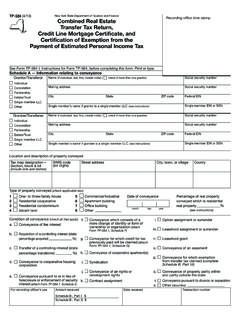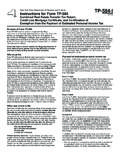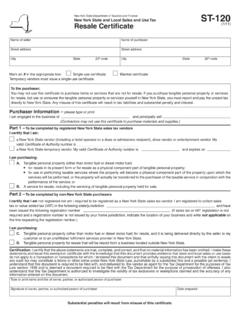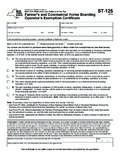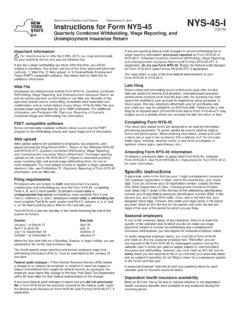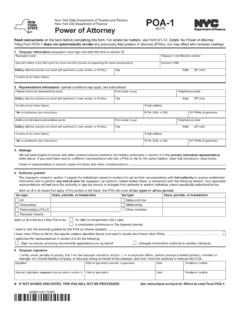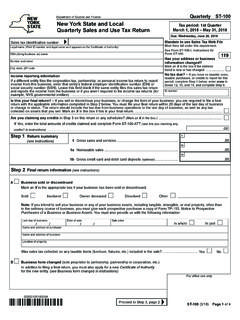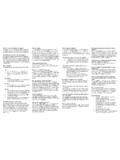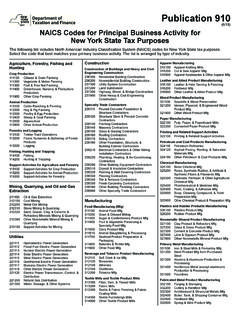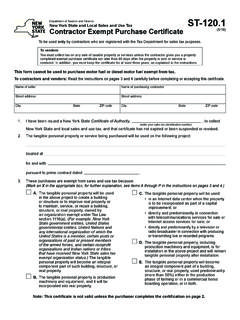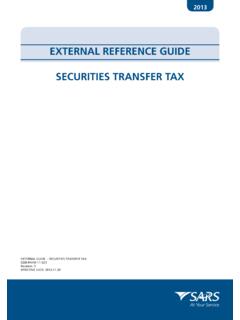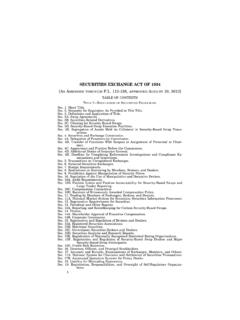Transcription of Estate Tax Waivers - Government of New York
1 1 When a person dies, the property he or she owned at the time of death, either outrightor as a partial interest, makes up the Estate assets. These assets may include realproperty (house and/or land), tangible personal property ( , car or jewelry), orintangible personal property ( , bank accounts, life insurance proceeds, stocks orbonds).In New york State, each county has a surrogate s court that is responsible for handlingestate matters. For a resident of New york State, the surrogate s court in the countywhere the deceased was domiciled at the time of death is the proper court ofjurisdiction. If a nonresident had real property in New york State, the surrogate s courtin the county where the real property is located has jurisdiction over an ancillaryproceeding. An ancillary proceeding is necessary to execute an executor s deed,transferring title to the real property of a nonresident surrogate s court determines the authenticity (probate) of the decedent s will andauthorizes the person or persons named in the will as executor(s) to carry out theirduties.
2 The court also sees that Estate assets are distributed in accordance with theterms of the will, and resolves any conflict between the language of the will andexisting law. If the individual dies without a will (intestate), the court appoints anadministrator and oversees the distribution of the assets under the rules of intestacy asapplicable in New is the process of proving before a court that the document offered as thedeceased individual s last will and testament is that are to be distributed according to the wishes of the deceased, as expressedin his or her will, are referred to as probate assets and make up the probate 603 (3/00)New york State Department of Taxation and FinanceEstate Tax WaiversWhat are Estate assets?What court hasauthority over adeceased individual sestate?Duties of the courtWhat is probate?What are probateassets and the probateestate?Note: An Estate tax waiver is not required for the Estate of an individual whose date of death is onor after February 1, see Which estates are required to file a New york State Estate tax return?
3 On page 7 for filing requirementsapplicable to these from the probate Estate are those assets that pass by operation of law and notunder the terms of the will. Included are bank accounts held as joint tenants with rightof survivorship and life insurance proceeds payable to a named beneficiary. Theseassets are said to pass outside the Estate (probate Estate ), which sometimes leads toconfusion as to what assets should be included in a deceased individual s (decedent s) Estate for Estate tax Estate tax purposes, a decedent s Estate consists of all property in which thedecedent had an interest, and includes property that is often excluded from the of appointment are legal documents issued by a court that has jurisdiction overthe Estate of the deceased individual. They authorize the person named to act on behalfof the Estate , and may set limitations on the powers of the person named. For purposesof this publication they include letters testamentary and letters of New york State, the surrogate s court, in the county where the deceased was aresident prior to his or her death, has jurisdiction over the Estate .
4 If the deceased left awill, the justice of the surrogate s court issues letters testamentary to the individualnamed in the decedent s will to act as executor. In the absence of a will, the justiceissuesletters of administration to the person designated to administer the Estate . Again,there may be limitations placed on the person to whom the letters are ensure collection of the proper Estate tax, the Tax Department has establishedguidelines for the release of property held by banks, stockbrokers, insurancecompanies, etc. In most cases, these guidelines allow the partial release of assets, sothe Estate may remain solvent. In some cases, the entire asset may be released withoutauthorization from the authorization is required for the release of personal property, this authorizationis generally referred to as an Estate tax waiver or a consent to totransfer real property is referred to as a release of lien. A validated Form ET-99, EstateTax Waiver Notice, is the waiver, and a validated Form ET-117, Release of Lien ofEstate Tax, is the release of a waiver and subject to limitations established by regulation, no person orinstitution in possession of the assets of a decedent may transfer those assets unlessnotice of the transfer is given to the Commissioner of Taxation and Finance at least 10days prior to the transfer , and a sufficient portion of the assets is retained to pay anyestate tax on those waiver or consent to transfer releases the institution (or person) holding the assetsfrom these requirements without liability for the Estate tax.
5 However, obtaining anestate tax waiver does not release the executor or the beneficiary from his or herliability for any Estate tax are non-probateassets?What property isincluded in the estatefor Estate tax purposes?What are letters ofappointment?Who issues letters ofappointment?What control does theTax Department haveover the release of adecedent s assets?What is a waiver or arelease of lien?Does a waiver releaseanyone fromresponsibility for theestate tax?3 The executor or person acting as executor (including a person applying for Waivers )may be held personally liable for unpaid Estate tax if he or she distributes assets to abeneficiary of the Estate before payment in full of the New york State Estate beneficiaries of the Estate may be held personally liable for the Estate tax, up to thevalue of the property received from the executor generally has authority under the Estates, Powers and Trusts Law torequire reimbursement by the beneficiaries of an Estate for Estate taxes will need an Estate tax waiver for the release of the following assets.
6 Money on deposit with an institution, including IRA s (individual retirementaccounts), Keogh Plans and annuities (that are not part of an employee pension orprofit sharing plan or trust), checking and savings accounts, and CD s (certificatesof deposit), if the aggregate of all deposits with that institution exceeds $30,000, asvalued on the date of death, when held: in the name of the deceased individual alone, including accounts held in trust foranother (Totten Trusts), unless held in trust for the surviving spouse only, or thesurviving spouse is named as the sole beneficiary of the IRA, Keogh Plan orannuity; or in the name of the deceased individual as custodian of an account establishedunder the Uniform Transfers to Minors Act, for a person who has not reached theage of 21 (or 18, if that age was elected by the transferor), when the custodian isthe donor of the property; or jointly in the name of the deceased individual and one or more other individuals,unless held by the deceased and his or her spouse as the only joint tenants.
7 Open market securities , if the total amount held in accounts with a brokerage house,the aggregate amount presented to a broker or other transfer agent, or the totalamount of securities of a single entity (corporation) exceeds $30,000,as valued onthe date of request for transfer , when held: in the name of the deceased individual alone, including accounts held in trust foranother (Totten Trusts), unless held in trust for the surviving spouse only; or in the name of the deceased individual as custodian of securities purchased underthe Uniform Transfers to Minors Act, for a person who has not reached the age of21 (or 18, if that age was elected by the transferor), when the custodian is thedonor of the property; or jointly in the name of the deceased individual and one or more other individuals(regardless of who established the joint account or the share of contributions),unless held by the deceased and his or her spouse as the only joint is responsible forthe Estate tax on theassets released?
8 What assets require awaiver and what arethe exceptions?MoniesSecurities4 Proceeds from life insurance policies, if the total amount payable by an insurancecompanyexceeds $50,000, valued as of the date of addition to the waiver requirements, the department must be notified in writingby the insurer if it intends to pay out part of the proceeds without a waiver and theamount to be paid out exceeds $30,000, but does not exceed $50,000. Notificationmay be mailed to the department at the time payment is made to the the surviving spouse is named on the insurance policy as the only beneficiary, theentire proceeds may be paid to the surviving spouse without a waiver and withoutnotifying the department. Payment of death benefits from an employee pension or profit sharing plan or trustif the total exceeds $50,000, valued as of the date of department must be notified in writing by the plan or trust if it intends to payout part of the proceeds without a waiver and the amount to be paid out exceeds$30,000, but does not exceed $50,000.
9 Notification may be mailed to thedepartment at the time payment is made to the the surviving spouse is named as the only beneficiary of the death benefits, theentire proceeds may be paid to the surviving spouse without a waiver and withoutnotifying the may be requested for: property held in storage by a warehouseman stock in a closely held corporation an interest in a partnershipA decedent s safe deposit box may be opened without authorization from the TaxDepartment under the following circumstances: The opening of a decedent s safe deposit box pursuant to a surrogate s court WillSearch Order where the person named in the order is authorized to remove papersthat appear to be a will of the deceased, the deed to a burial plot, and any lifeinsurance policies on the life of the deceased that are payable to a namedbeneficiary. If there are other contents in the safe deposit box, they may not beremoved and the box must be sealed until a release is obtained from the department.
10 When there is a joint lessee or a person who was authorized by the deceased to haveaccess to the safe deposit box, that person is permitted to copy any papersexpressing the wishes of the deceased concerning burial, or other disposal of his orher remains, and a deed to a cemetery plot or proof of membership in a burialsociety. The original papers must be returned to the box and the box sealed until arelease is obtained from the insurancePensions and death benefitsWhat other assets maywaivers be requested for?May someone open thedeceased s safe depositbox withoutauthorization from theTax Department?Will Search OrderTo photocopy importantpapers5To apply for a release of a safe deposit box, obtain Form ET-92, Application forRelease of Safe Deposit Box. Complete the application and mail it with a photocopy ofthe death certificate to the address indicated on the form. An authorization letter will beissued, authorizing the bank to release the safe deposit box to the authorizedrepresentative of the Estate .
